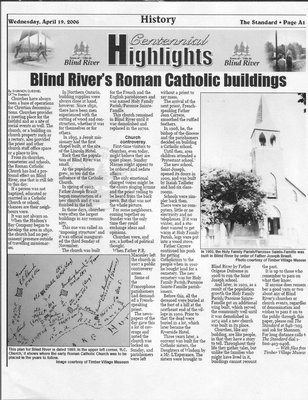Blind River's Roman Catholic Buildings - The Standard, 2006
- Full Text
Wednesday, April 19, 2006
History
The Standard • Page Al
Blind River's Roman Catholic Buildings
By Shannon Quesnel Of the Standard
Churches have always been a base of operations for Christian denominations. Churches provides a meeting place for the faithful and as a site of social events as well. The church, or a building on church property such as a rectory, also provided the priest and other church staff office space or a place to live.
From its churches, cemeteries and schools, the Roman Catholic Church has had a profound effect on Blind River, one that is still felt to this day.
If a person was not baptized, educated or married in a Catholic Church or school, chances are their neighbors were.
It was not always so.
When the Hudson's Bay Company began to develop the area in 1850, the church had no permanent presence outside of traveling missionaries.
In Northern Ontario, building supplies were always close at hand, however. Since 1850, there have been men experienced with the cutting of wood and construction, whether it was for themselves or for others.
In 1805, a Jesuit missionary had the first chapel built, at the site of the Lincoln Hotel.
Back then the population of Blind River was small.
As the population grew, so too did the influence of the Catholic Church.
In spring of 1903, Father Joseph Brault began construction of a new church and it was finished in the fall.
In those days, churches were often the largest buildings in any community.
This one was called an 'imposing structure" and it was official inaugurated the third Sunday of November.
The church was built for the French and the English parishioners and was named Holy Family Parish/Paroisse Sainte-Famille.
This church remained in Blind River until it was demolished and replaced in the 1970s.
Church Controversy
First-time visitors to churches, even today, might believe they are quiet places. Sunday Masses might appear to be ordered and sedate affairs.
The only emotional charged voices might be the choirs singing hymns and the priest yelling to be heard from the back pews. But that was not the whole picture.
For some neighbors, coming together on Sunday was the only time they could exchange ideas and opinions.
Churches were, and are, a hotbed of political thought.
When Father P.R. Macauley left the church in 1907 a public controversy arose.
Some of the Francophone parishioners nad demanded a French-speaking priest.
The newspapers of the day gave this a lot of coverage and noted the church was locked on Sunday, and parishioners were left without a priest to say mass.
The arrival of the next priest, French-speaking Father Jean Carrere, smoothed the ruffled feathers.
In 1908, he, the bishop of the diocese and the parishioners decided on building a Catholic school.
Until then, area children attended a Protestant school.
The new school, Saint-Joseph, opened its doors in 1909, and was built by Isaiah Taillefer and had six classrooms.
Schools were simpler back then. There were no computers. little or no electricity and no telephones. If it was winter, and a student wanted to get warm at Holy Family Parish, logs were put into a wood stove.
Father Carrere continued his push for getting Catholicism to the people when in 1910 he bought land for a cemetery. The new cemetery was for Holy Family Parish/Paroisse Sainte-Famille parishioners.
Before this, all the deceased were buried at the foot of a hill at the northeast end of the village in 1906. Prior to that the dead were buried in a lot, which later became the Riverside Hotel.
Three years later, a convent was built for the Catholic sisters, the Daughters of Wisdom by a Mr. L'Esperance, the sisters were brought to Blind River by Father Origene Dufresne in 1908 to run the Saint Joseph school.
And later, in 1929, as a result of the population growth the Holy Family Parish/Paroisse Sainte-Famille got an additional wing built, which served the community well until it was demolished in 1974 and a new church was built in its place.
Churches, like any building, are like people, in that they have a story to tell. Throughout then-life they gather tales, but unlike the families who might have lived in it , buildings cannot recount the past.
It is up to those who remember to pass on what they know.
If anyone does remember a good yam or two about any of Blind Rivers churches or church events, regardless of denomination and wishes to pass it on to the public through this paper, please call The Standard at 846-7195 and ask for Shannon.
For long distance calls to the Standard dial 1-800-403-0408.
- With files from Timber Village Museum
- Creator
- Shannon Quesnel, Author
- Media Type
- Text
- Image
- Item Type
- Clippings
- Description
- This article discusses the history of the role of the Catholic Church in Blind Rivers history and provides information about the building of Holy Family in 1903 and the coming of the catholic school.
- Date of Original
- April 19, 2006
- Subject(s)
- Collection
- Blind River History
- Language of Item
- English
- Copyright Statement
- Protected by copyright: Uses other than research or private study require the permission of the rightsholder(s). Responsibility for obtaining permissions and for any use rests exclusively with the user.
- Contact
- Blind River Public LibraryEmail:brpl.ceo@gmail.com
Website:
Agency street/mail address:8 Woodward Avenue
P.O. Box 880
Blind River, ON P0R 1B0
(705) 356-7616


